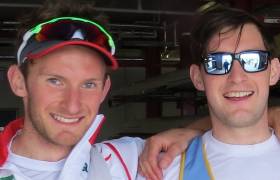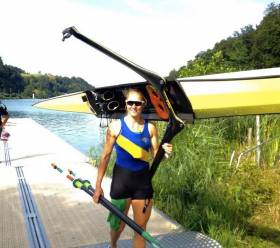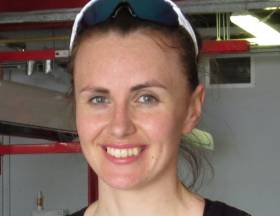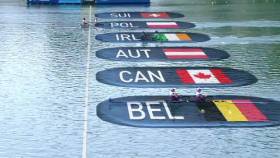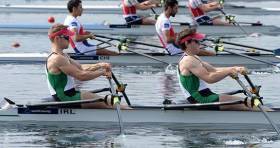Displaying items by tag: World Cup
Gold for O'Donovans at World Cup Regatta in Lucerne
#Rowing: Paul and Gary O’Donovan took gold at the World Cup Regatta in Lucerne this morning. Denmark and Belgium had good starts, but the Skibbereen men too over the lead after 800 metres. They held it from there, though Belgium pushed right up on them in the final quarter. The O’Donovans held them off to win by .8 of a second.
World Cup Regatta, Lucerne, Day Three (Selected Results; Irish interest)
Men
Pair – B Final (Places 7 to 12): 1 Spain Two 6:40.42; 3 Ireland (M O’Donovan, S O’Driscoll) 6:43.27.
Lightweight Double Sculls – A Final: 1 Ireland (G O’Donovan, P O’Donovan) 6:28.50, 2 Belgium 6:29.30, 3 Denmark 6:32.39.
Women
Pair – B Final: 1 Spain 7:25.23; 4 Ireland (A Keogh, T Hanlon) 7:32.46.
Double – B Final: 1 Czech Republic 7:05.30; 3 Ireland (M Dukarska, A Crowley) 7:06.92.
Puspure Wins Semi-Final at World Cup Regatta in Lucerne
#Rowing: Sanita Puspure won her semi-final of the single sculls at the World Cup Regatta in Lucerne with a dominant performance. Annekatrin Thiele of Germany disputed the lead in the first quarter, but Puspure led by the 1,000 metre mark and was clear by over four seconds at the finish. Austria’s Magdalena Lobnig pushed past Thiele to take second.
World Cup Regatta, Lucerne, Day Two (Irish interest; selected results)
Men
Pair – A/B Semi-Final One (First Three to A Final; rest to B Final): 1 Serbia 6:33.87, 2 Spain 6:36.65, 3 Britain One 6:38.90; 4 Ireland (M O’Donovan, S O’Driscoll) 6:42.02.
D Final (Places 19 to 24): 1 Poland 6:40.95; 5 Ireland (P Boomer, A Harrington) 6:53.83.
Single Sculls – C Final (Places 13 to 18): 1 Australia 6:58.52, 2 Argentina 6:59.65, 3 Ireland (P Doyle) 7:00.39.
Women
Pair - Repechage (First Two to A Final; rest to B Final): 1 Australia 7:18.62, 2 China One 7:19.86; 4 Ireland (A Keogh, T Hanlon) 7:29.63.
Double – Semi-Final (First Three to A Final; rest to B Final): 1 New Zealand 6:53.91, 2 Canada 6:57.71, 3 Netherlands 6:58.57; 4 Ireland (A Crowley, M Dukarska) 7:06.42.
Single Sculls – Semi-Final (First Three to A Final; rest to B Final): 1 Ireland (S Puspure) 7:39.59, 2 Austria (M Lobnig) 7:43.68, 3 Germany (A Thiele) 7:45.59.
Doyle Third After Leading C Final at Lucerne World Cup
#Rowing: Philip Doyle finished third in the C Final of the men’s single sculls at the World Cup Regatta in Lucerne this morning. The Queen’s University man led until the final quarter when Campbell Watts of Australia and Brian Rosso of Argentina got past him to take first and second. Doyle places 15th in his first regatta at this level in one of the toughest disciplines.
Earlier, Patrick Boomer and Andy Harrington had taken fifth in the D Final of the pairs.
World Cup Regatta, Lucerne, Day Two (Irish interest; selected results)
Men
Pair – D Final (Places 19 to 24): 1 Poland 6:40.95; 5 Ireland (P Boomer, A Harrington) 6:53.83.
Single Sculls – C Final (Places 13 to 18): 1 Australia 6:58.52, 2 Argentina 6:59.65, 3 Ireland (P Doyle) 7:00.39.
#Rowing: Paul O’Donovan and Gary O’Donovan won their heat to qualify directly for the semi-finals at the World Cup Regatta in Lucerne. The Ireland lightweight double scull took the lead from the start. They led Poland at halfway, but the Poles, who beat Ireland in the first World Cup in Belgrade, then took over. Austria pushed into the top three and these boats fought it out for two places. Ireland showed they had the speed in the dash to the line – and it was Poland who lost out, taking third.
Philip Doyle qualified for the quarter-finals of the single sculls with third place in his heat. Mahe Drysdale, the Olympic champion, was the likely winner, but Doyle led through the 500 metre mark. The big New Zealander took over and won. Sverri Nielsen of Denmark took second and Doyle was just behind him.
World Cup Regatta, Lucerne, Day One (Irish interest; selected results)
Men
Pair – Heat Two (First Four to Quarter-Final; rest to Quarter-Final or E Final): 1 Spain 6:40.29; 3 Ireland Two (P Boomer, P Harrington) 6:45.74
Heat Six (First Three to Quarter-Final; rest to Quarter-Final or E Final): 1 Croatia 6:37.66, 2 Ireland One (M O’Donovan, S O’Driscoll) 6:40.95.
Lightweight Double Sculls – Heat One (First two to A/B Semi-Finals; rest to Repechage): 1 Ireland (G O’Donovan, P O’Donovan) 6:17.43, 2 Austria 6:17.79; 3 Poland 6:17.91.
Single Sculls – Heat One (First Four to Quarter-Final; rest to Quarter-Final or E Final): 1 New Zealand (M Drysdale) 6:52.98; 3 Ireland (P Doyle) 6:55.18.
Women
Pair – Heat Two (First to A Final; rest to Repechage): 1 Canada 7:13.98; 6 Ireland (A Keogh, T Hanlon) 7:32.49.
Double Sculls – Heat Two (First Three to A/B Semi-Finals; rest to Repechages): 1 United States 6:58.58, 2 Ireland (A Crowley, M Dukarska) 7:03.05.
Single Sculls – Heat One (First to A/B Semi-Final; rest to Repechages): 1 Ireland (S Puspure) 7:26.51; 2 United States 7:40.98.
#Rowing: Sanita Puspure won her heat of the single sculls impressively to qualify directly for the semi-final of the World Cup Regatta in Lucerne. Puspure was tested somewhat to 1500 metres by Kara Kohler of the United States, but only the winner would avoid the repechage, and the Ireland sculler built her lead. Kohler slipped back and settled for second. Three other Ireland crews had already hit the mark in their heats.
World Cup Regatta, Lucerne, Day One (Irish interest; selected results)
Men
Pair – Heat Two (First Four to Quarter-Final; rest to Quarter-Final or E Final): 1 Spain 6:40.29; 3 Ireland Two (P Boomer, P Harrington) 6:45.74
Heat Six (First Three to Quarter-Final; rest to Quarter-Final or E Final): 1 Croatia 6:37.66, 2 Ireland One (M O’Donovan, S O’Driscoll) 6:40.95.
Women
Pair – Heat Two (First to A Final; rest to Repechage): 1 Canada 7:13.98; 6 Ireland (A Keogh, T Hanlon) 7:32.49.
Double Sculls – Heat Two (First Three to A/B Semi-Finals; rest to Repechages): 1 United States 6:58.58, 2 Ireland (A Crowley, M Dukarska) 7:03.05.
Single Sculls – Heat One (First to A/B Semi-Final; rest to Repechages): 1 Ireland (S Puspure) 7:26.51; 2 United States 7:40.98.
#Rowing: Three of the four Ireland boats in early action at the World Cup Regatta in Lucerne qualified directly from their heats and avoided repechage action.
Shane O’Driscoll and Mark O’Donovan took second place in their heat of the men’s pairs and secured a place in the quarter-finals. The world lightweight champions came up against the outstanding Sinkovic brothers from Croatia, who won the race with a sparkling performance. The key battle behind them was not to finish last. Brazil and Australia battled with Ireland, but O’Donovan and O’Driscoll moved away from both, collared second place and held on to it.
Patrick Boomer and Andy Harrington secured third place in their heat. Their qualification looked in doubt as they battled with Croatia at the back of the field. But the big Ireland crew found speed when they needed it. They produced the fastest final quarter, and left the Croats behind them. China faded badly and took the last place.
The women’s double of Monika Dukarska and Aileen Crowley qualified directly for the A/B Semi-Finals with a solid second place. The United States crew of Megan O’Leary and Ellen Tomek were convincing winners, while Dukarska and Crowley held on to second despite a late charge by China, who pushed Switzerland into the repechage.
In the women’s pair, the new crew of Aifric Keogh and Tara Hanlon finished sixth in their heat and are set for a repechage.
World Cup Regatta, Lucerne, Day One (Irish interest; selected results)
Men
Pair – Heat Two (First Four to Quarter-Final; rest to Quarter-Final or E Final): 1 Spain 6:40.29; 3 Ireland Two (P Boomer, P Harrington) 6:45.74
Heat Six (First Three to Quarter-Final; rest to Quarter-Final or E Final): 1 Croatia 6:37.66, 2 Ireland One (M O’Donovan, S O’Driscoll) 6:40.95.
Women
Pair – Heat Two (First to A Final; rest to Repechage): 1 Canada 7:13.98; 6 Ireland (A Keogh, T Hanlon) 7:32.49.
Double Sculls – Heat Two (First Three to A/B Semi-Finals; rest to Repechages): 1 United States 6:58.58, 2 Ireland (A Crowley, M Dukarska) 7:03.05.
#Rowing: Ireland’s Aifric Keogh and Emily Hegarty finished third in the women’s pair B Final as the rain came down at the World Cup Regatta in Belgrade. The racing for the day had been brought forward because of the forecast of storms and as this last race progressed the bad weather swept in. Poland had taken the lead early and not yielded it. Keogh and Hegarty also slotted into a spot, third, and despite changes in the order, they finished there, closing up fast on second-placed China Three coming to the line.
Monika Dukarska and Aileen Crowley also took third in the B Final of the women’s double, placing ninth overall. France, Switzerland and Ireland moved away from the field early on and crossed the line in that order.
The Ireland lightweight double of Denise Walsh and Margaret Cremen took sixth in their B Final, 12th overall. The were off the pace in a race won by Canada.
World Cup Regatta, Belgrade, Day Three (Irish interest)
Men
Lightweight Double Sculls – A Final: 1 Poland 6:13.04, 2 Belgium 6:14.09, 3 (G O’Donovan, P O’Donovan) 6:14.10; 4 Canada Two 6:17.27, 5 Austria 6:17.32, 6 Switzerland Two 6:23.87.
Women
Pair – B Final: 1 Poland 7:14.30; 3 Ireland (A Keogh, E Hegarty) 7:16.37.
Double Sculls – B Final: 1 France 6:58.86; 3 Ireland (A Crowley, M Dukarska) 7:03.79.
Lightweight Double Sculls – B Final: 1 Canada 6:55.88; 6 Ireland (M Cremen, D Walsh) 7:07.77.
Single Sculls – A Final: 1 Switzerland (J Gmelin) 7:22.78, 2 Ireland (S Puspure) 7:25.30, 3 Austria (M Lobnig) 7:25.51; 4 Germany 7:27.84, 5 Britain 7:27.93, 6 Denmark 7:31.96.
#Rowing: Sanita Puspure took an excellent silver medal at the World Cup Regatta in Belgrade this morning. Jeanine Gmelin of Switzerland took the gold with a commanding performance, overtaking early leader Magdalena Lobnig of Austria by halfway.
Puspure raced well, taking a clear third place by the closing stages and then beating Lobnig in a battle for the silver.
World Cup Regatta, Belgrade, Day Three (Irish interest)
Men
Lightweight Double Sculls – A Final: 1 Poland 6:13.04, 2 Belgium 6:14.09, 3 (G O’Donovan, P O’Donovan) 6:14.10; 4 Canada Two 6:17.27, 5 Austria 6:17.32, 6 Switzerland Two 6:23.87.
Women
Single Sculls – A Final: 1 Switzerland (J Gmelin) 7:22.78,
2 Ireland (S Puspure) 7:25.30
3 Austria (M Lobnig) 7:25.51; 4 Germany 7:27.84, 5 Britain 7:27.93, 6 Denmark 7:31.96.
#Rowing: Ireland’s Paul O’Donovan and Gary O’Donovan took a bronze medal at the World Cup Regatta in Belgrade this morning. The A Final of the lightweight double was tight and had an exciting finish. Ireland started well, but Poland took the lead and held it through to the 1500 metres mark, with Ireland, Austria and Belgium exerting pressure. The Irish moved in the final 500 metres – but so did Poland. Jerzy Kowalski and Milosz Jankowski drove for the line and won. Belgium caught the Irish and passed them on the line. The took the silver by one hundredth of a second.
World Cup Regatta, Belgrade, Day Three (Irish interest)
Men
Lightweight Double Sculls – A Final: 1 Poland 6:13.04, 2 Belgium 6:14.09, 3 (G O’Donovan, P O’Donovan) 6:14.10; 4 Canada Two 6:17.27, 5 Austria 6:17.32, 6 Switzerland Two 6:23.87.
#Rowing: Paul O’Donovan and Gary O’Donovan brought Ireland a second A Final place at the World Cup Regatta in Belgrade as they won their semi-final of the lightweight double sculls. The Skibbereen men moved through the early leaders to lead by halfway and they held the lead to the finish, though Poland closed to within a second on the line. Belgium held off the Czech Republic to take third.
Denise Walsh and Margaret Cremen finished sixth in the second semi-final of the women’s lightweight double. The United States won the race from Switzerland and the Netherlands. The Ireland crew found it hard to make an impression and held sixth from early on.
Sanita Puspure had taken her place in the A Final of the women’s single sculls with second place in her semi-final.
World Cup Regatta, Belgrade, Day Two (Irish interest)
Men
Pair – C Final (Places 13 to 18): 1 Hungary 6:55.35, 2 Greece 6:57.73, 3 Ireland (M O’Donovan, S O’Driscoll) 6:59.0, 4 South Africa 7:00.22.
Lightweight Double Sculls – Semi-Final Two (Three to A Final; rest to B Final): 1 Ireland (G O’Donovan, P O’Donovan) 6:22.28, 2 Poland 6:22.87, 3 Belgium 6:24.21.
Women
Pair – Semi-Final Two (Three to A Final; rest to B Final): 1 Spain 7:35.18, 2 Denmark 7:35.77, 3 Britain Two 7:39.35; 4 Ireland (A Keogh, E Hegarty) 7:42.60.
Double Sculls – Semi-Final (Three to A Final; rest to B Final): Netherlands 7:16.27, 2 Belarus One 7:18.73, 3 Belarus Two 7:23.46; 4 Ireland (A Crowley, M Dukarska) 7:25.60.
Lightweight Double Sculls - Semi-Final (Three to A Final; rest to B Final): 1 United States One 7:03.73, 2 Switzerland 7:05.94, 3 Netherlands 7:06.04; 6 Ireland (M Cremen, D Walsh) 7:24.87.
Single Sculls – Semi-Final (Three to A Final; rest to B Final): 1 Denmark (F Erichsen) 7:24.76, 2 Ireland (S Puspure) 7:25.43, 3 Britain (V Thornley) 7:25.78.



























